//The Science of Heated Tobacco: Risk Perception and Intention to Use
Posted 06/10/2021 12:00pm
Any viable less harmful alternatives to cigarettes must be acceptable to those adult smokers who would otherwise continue to smoke, but should not appeal to non-smokers. This infographic blog explores a key pre-market study assessing perceptions and intentions to use Imperial’s heated tobacco device, Pulze, Dr Thomas Nahde, Head of Scientific and Regulatory Affairs (DACH and Nordics) at Imperial Brands, explains.
Next Generation Products (NGPs) provide satisfying, potentially harm reduced alternatives for adult smokers who would otherwise continue to smoke. Many adult smokers have not yet tried a less harmful, technology-driven product, or may be sceptical toward them.
Heated tobacco (HT) represents one of the most promising developments in nicotine science. Compared to other next-generation alternatives, it more closely replicates elements of the traditional smoking experience. HT provides adult smokers with the nicotine satisfaction and tobacco aromas they desire along similar behavioural and sensorial rituals as combustible cigarettes, but importantly with fewer and substantially lower levels of the harmful chemicals than present in cigarette smoke. Together, these factors mean HT is likely to offer a more satisfying and viable alternative for more adult smokers who would otherwise continue to smoke.
Pulze is our innovative HT device. By heating an iD consumable, comprised of reconstituted refined tobacco to no higher than 345°C, it produces an inhalable aerosol containing on average 96% lower levels of select harmful chemicals of public health interest compared to combustible cigarette smoke.
While these preliminary testing figures are encouraging, a product’s tobacco harm reduction (THR) potential doesn’t solely depend on its risk reduction profile compared to smoking; it’s also determined by adult smoker acceptance.
The THR impact of any NGP may be minimised if adult smokers neither like nor use it as an alternative to continued combustible cigarette smoking. NGPs must therefore be acceptable and satisfying to adult smokers to offer a viable alternative to smoking. However, it’s also crucial these products aren’t appealing to non-users, including vulnerable groups such as youth and ‘never smokers’.
Together these two factors contribute to population-level THR. Supported by the available evidence, we’ve developed our own modified THR equation to help explain this concept:

Our modified tobacco harm reduction equation
As the graphic shows, when we discuss consumer acceptance of NGPs, we really mean intended consumer acceptance – i.e. consumer acceptance by adult smokers who would otherwise continue to smoke. The introduction of any NGP which contributes to THR must therefore strike a balance, maximising the ‘off-ramp’ from combustible cigarettes amongst adult smokers while minimising and eliminating any potential ‘on-ramp’ to nicotine among non-users.
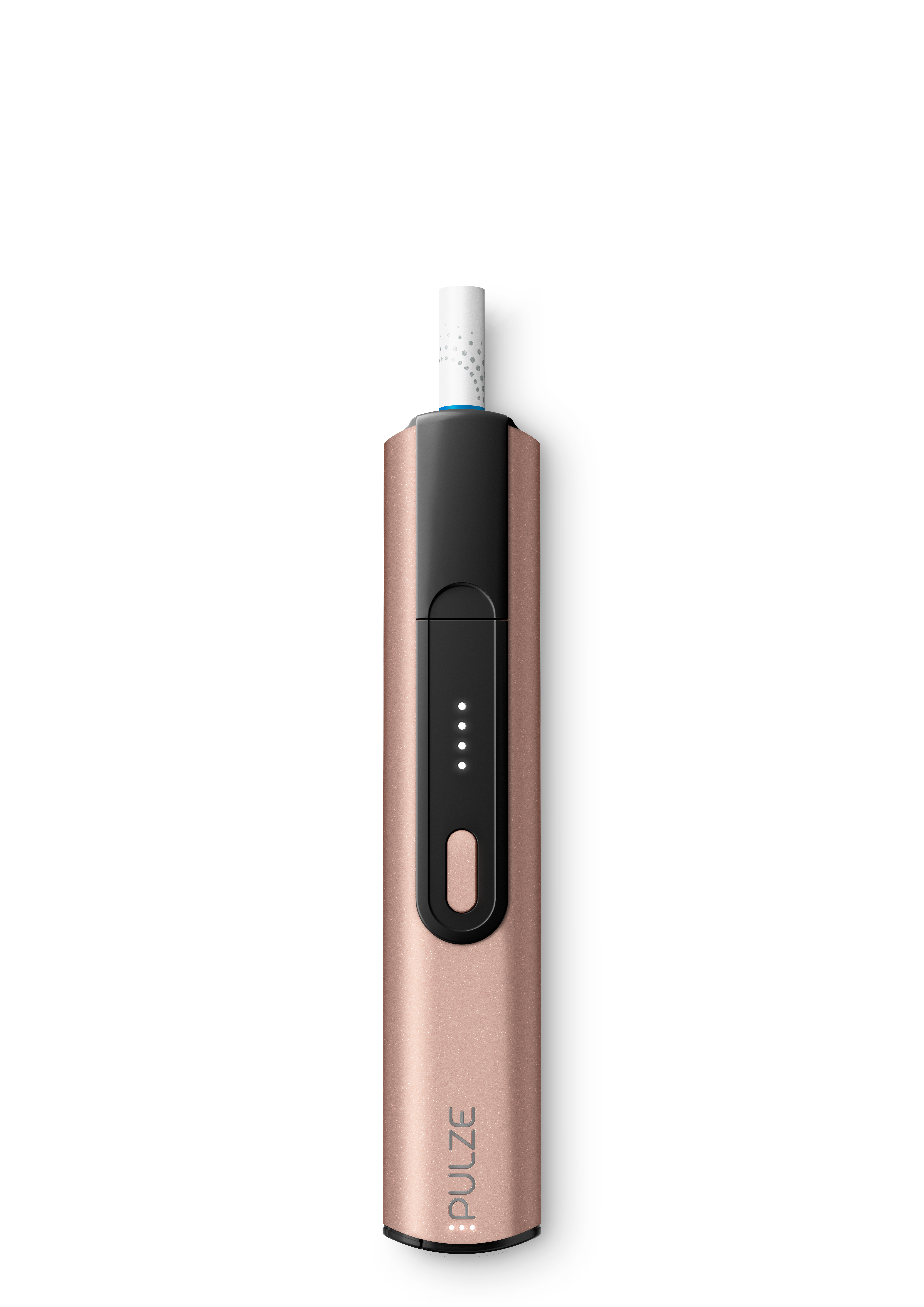
Pulze – our innovative heated tobacco device
Pre-market perceptions of Pulze
To assess the Pulze HT device with its iD tobacco consumables through this lens, between September and October 2020 we conducted two cross-sectional studies involving 4848 adult smokers, HT and vape users – as well as non-users of tobacco and nicotine products. They were all aged between 18-60, and living in Italy, Greece or Germany.
Given they were pre-market studies (i.e. Pulze and iD tobacco consumables weren’t actually for sale in any of these markets), this research assessed the product’s perception rather than actual use, evaluating participants’ behavioural intentions and risk perceptions toward the product after viewing the packaging and user guide.
If a product’s risk is not properly understood, it could limit the THR potential of the product and reduce the likelihood adult smokers will use it as alternative to combustible cigarettes. Conversely, if an NGP is incorrectly perceived as risk-free it may be used by unintended audiences.
Encouragingly, the data indicates that while Pulze is appealing to adult smokers – who would likely use it to replace or reduce their combustible cigarette consumption – it isn’t attractive to non-users. Simultaneously, the Pulze HT device and iD tobacco consumables are generally understood as being less harmful than cigarettes, but is also correctly perceived as not risk-free.
When asked to consider the relative risks of various non-combusted nicotine products (including Pulze and iD tobacco consumables) compared to cigarettes, participant opinions were slightly more nuanced – illustrating how some of the pervasive misperceptions associated with NGPs and nicotine can negatively impact the THR-potential of the HT category as well as highlighting the urgent need for fact-based consumer education.
Download our infographic to find out more, or keep reading for a detailed breakdown of both intentions to use and risk perceptions concerning Pulze.
Pulze’s adult smoker appeal
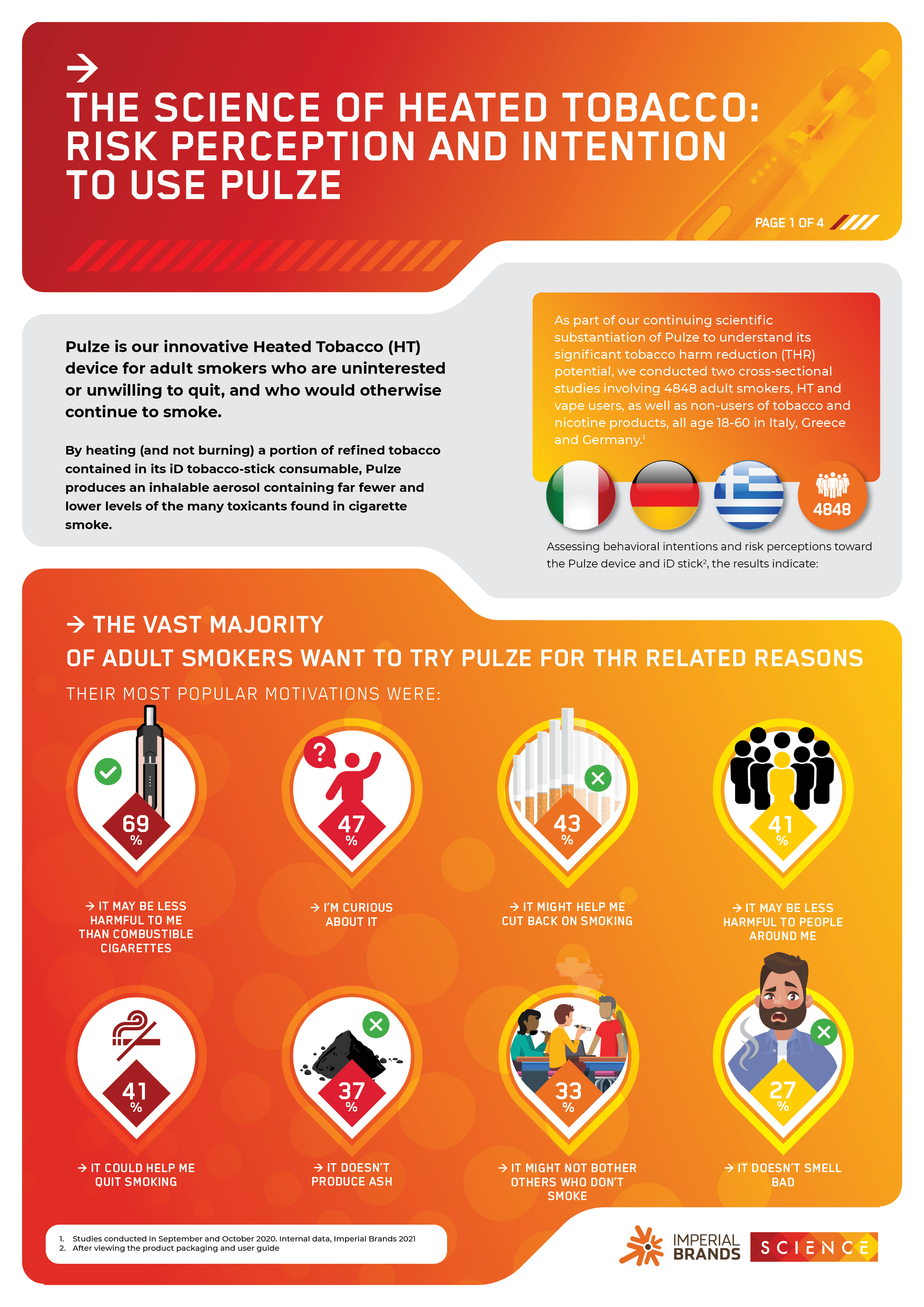
The Science of Heated Tobacco: Risk Perception and Intention to Use Pulze (Page 1)
Our findings suggest adult smokers want to try Pulze and iD tobacco consumables for THR-related reasons, with the most popular motivation being: “it may be less harmful to me than combustible cigarettes” (69%). In second place, “it might help me cut back on smoking” (43%) and “it may be less harmful to people around me” (41%) followed closely in third.
While these figures indicate adult smokers’ awareness of the risks of combustible cigarettes for both themselves and others, they also recognise Pulze and iD tobacco consumables may provide a potentially less harmful alternative for these users over continuing to smoke.
Simultaneously, of those adult smokers who would purchase Pulze and iD tobacco consumables, 74% said they would use it in place of combustible cigarettes – either completely or partially. This suggests that a substantial number of adult smokers may use the product to transition away from smoking.
Equally, Pulze doesn’t appeal to non-smokers

The Science of Heated Tobacco: Risk Perception and Intention to Use Pulze (Page 2)
While it’s promising adult smokers find Pulze an attractive alternative to combustible cigarettes, it’s crucial to understand if this appeal is mirrored in non-smoker populations.
Our research found that 94% of non-users of nicotine and tobacco products wouldn’t use Pulze and iD tobacco consumables.
This non-user group included never-users of either tobacco or nicotine products, as well as former smokers.
When taken alongside the encouraging adult smoker acceptance data, this evidence of limited non-user appeal addresses both sides of the THR equation, proving promising evidence of the significant harm reduction potential of the Pulze HT device and iD tobacco consumables.
Risk perceptions of Pulze and iD tobacco consumables
In the context of THR and NGPs, there are two ways we can explain risk:
- Absolute risk assesses the totality of the risks of using a product – and the likelihood of this risk leading to an adverse health event, like disease. For example, compared to never smoking at all, the absolute risk of using combustible cigarettes is high, as it can cause lung cancer, heart disease and emphysema in adult smokers.
- Relative risk on the other hand considers the risk of developing adverse health events within the context of continuing to smoke. For instance, Public Health England’s statement that vaping is around “95% less harmful than smoking” is an often-cited example of relative risk communications. This concept of relative risk – i.e. risk in relation to continued smoking of combustible cigarettes – is a cornerstone of THR and an important consideration given the overwhelming majority of NGP users are current or former smokers
Absolute risk
When all participants were quizzed about the absolute risk of smoking combustible cigarettes, 53% thought they were “extremely harmful”. However, only 14% felt Pulze and its iD tobacco consumables possessed the same risk level, suggesting the majority recognised its harm reduction potential and the fact HT is a distinct product category from combustible cigarettes.
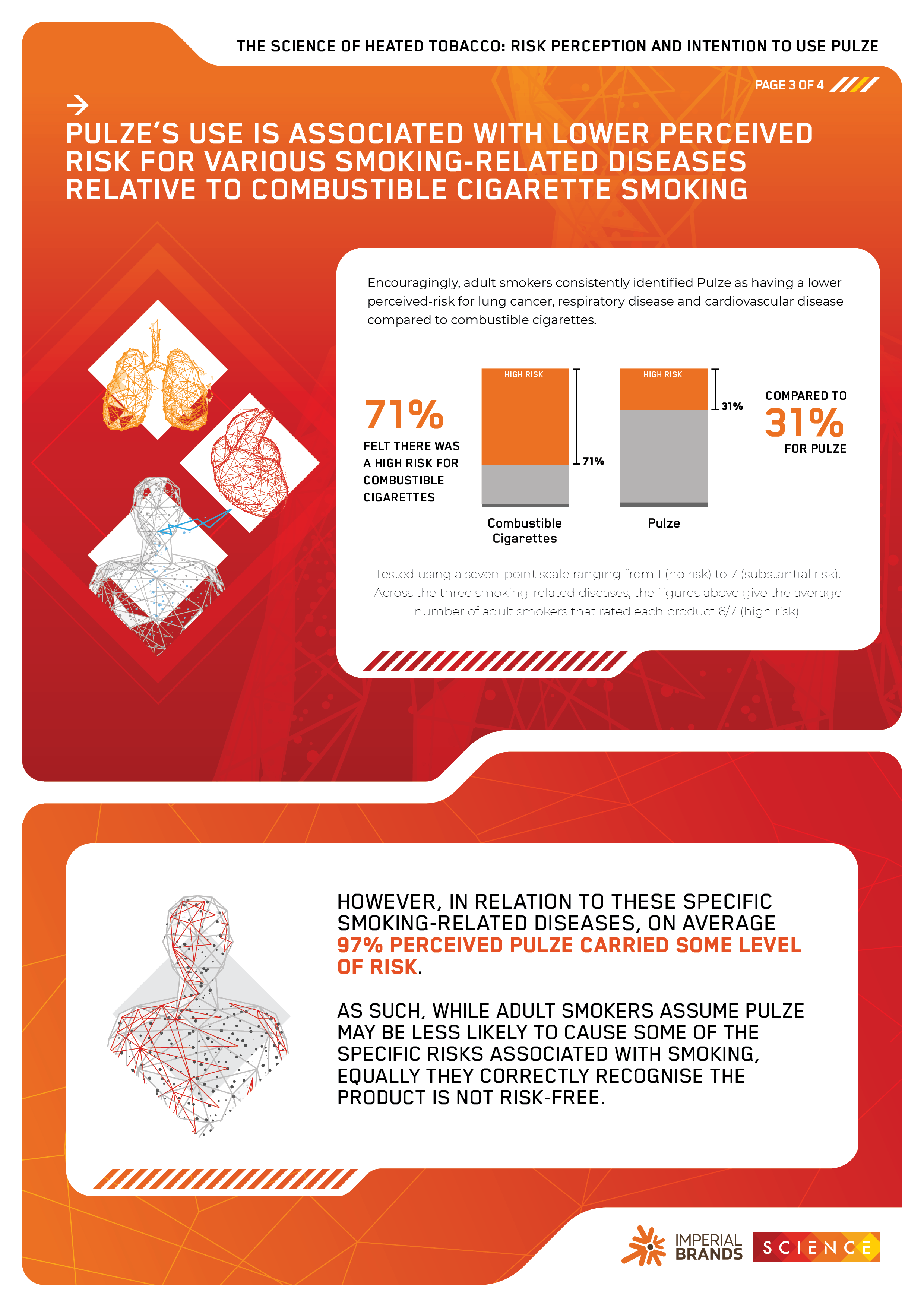
The Science of Heated Tobacco: Risk Perception and Intention to Use Pulze (Page 3)
Importantly, just 2% thought Pulze presented no risk at all, demonstrating the vast majority recognised – as with any nicotine-containing product –HT products are not risk-free.
Disease-specific perception
Adult smokers were then asked to consider the absolute risk relating to several specific smoking related diseases, including lung cancer, respiratory and heart disease.
While 71% felt there was a high risk of developing these illnesses through smoking combustible cigarettes, less than half that number (31%) felt Pulze and iD tobacco consumables presented the same high level of risk.[1] However, for these specific illnesses, the vast majority (97%) recognised Pulze and iD tobacco consumables carry some level of risk.
So, while adult smokers perceive the product may be considerably less likely to cause some of the specific harms associated with smoking, they also correctly recognise it is not risk-free.
Because risk perceptions may be an important motivator in driving adult smokers’ “off-ramp” from combustible cigarettes, in this initial data it’s encouraging to see adult smokers correctly understand the risks associated with both combustible cigarettes and Pulze with iD tobacco consumables respectively.
Relative risks
When all participants were asked to consider the relative risks of various non-combustible nicotine products (including Pulze) directly to cigarettes, the results were less clear cut.
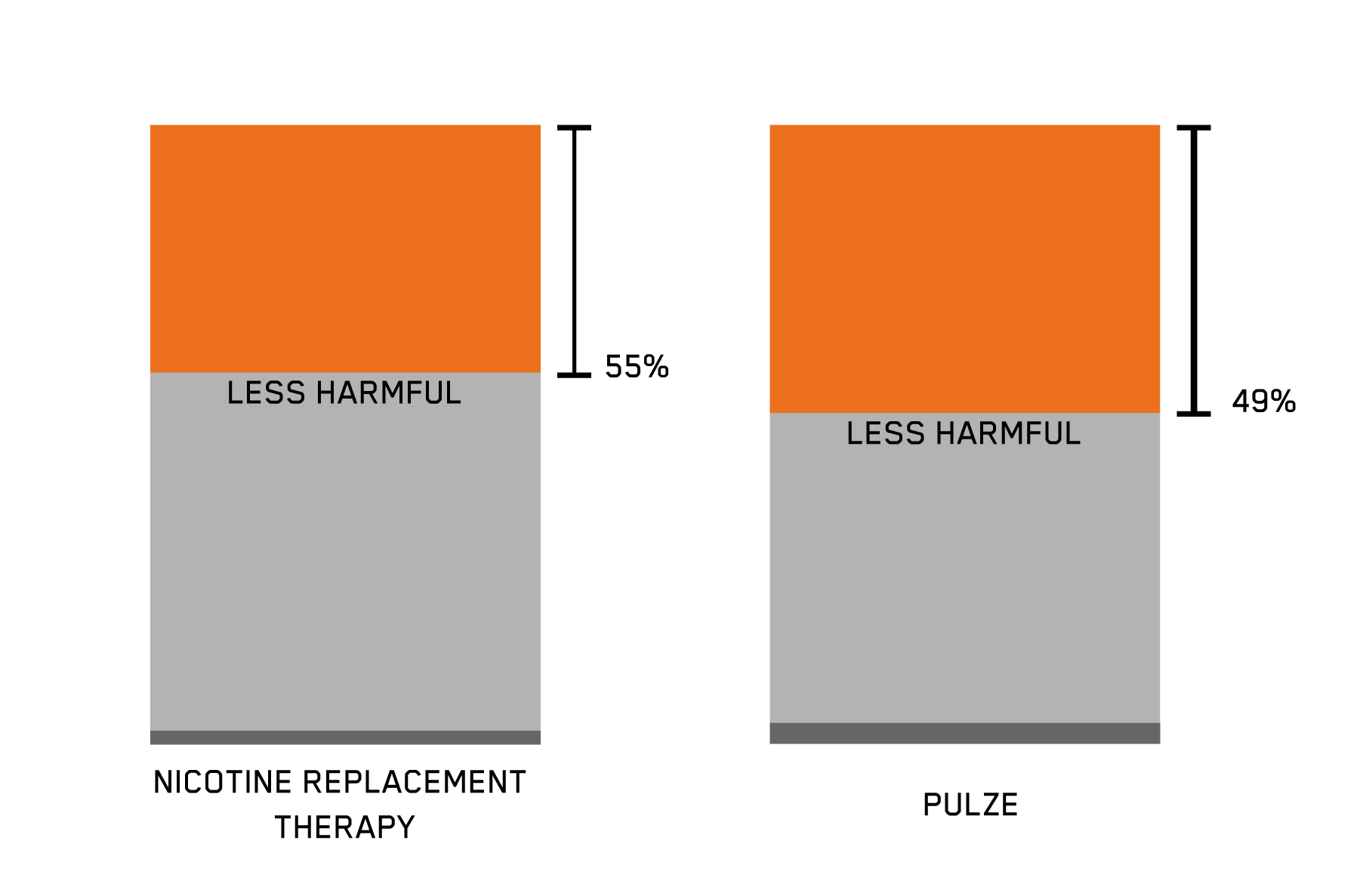
Relative risks: the difference in risk perceptions between nicotine replacement therapies and Pulze. The graph shows the percentage of participants that rated each product “much less harmful” or “less harmful”
Of those who agreed each product was “much less harmful” or “less harmful” compared to combustible cigarettes, there was:
- 49% for HT (e.g. Pulze and iD tobacco consumables)
- 55% for medicinal Nicotine Replacement Therapies (NRTs)
NRTs are widely endorsed as “safe” by regulators and recommended by many to help adult smokers quit smoking. Despite being a relatively nascent innovation, a growing body of scientific evidence shows HT products offer significant THR potential, leading numerous health groups and government bodies to conduct their own research or academic reviews into the category. Many have concluded its risk profile is favourable compared to continued smoking of combustible cigarettes and consider HT products to have an important role to play in THR strategies.
Given the above, participants’ relative risk figures for both categories may appear lower than expected. That said, it’s important to consider each of the percentages within the wider context of nicotine and public perceptions – often fraught with misunderstandings relating to its role in smoking-related disease.
While the risk perception data from this study is broadly positive, the estimations on relative risk may provide an insight into how pervasive misperceptions surrounding nicotine amongst adult smokers can negatively impact perceptions of smoking alternatives. If these beliefs remain out of step with the current scientific evidence, in future they may seriously hinder the positive and significant contribution NGPs are able to make to THR.
In conclusion, the data from this pre-market study suggests:
- Pulze and iD tobacco consumables have significant appeal to current adult smokers, but very low interest amongst non-smokers
- Adult smokers’ motivations to both try and purchase Pulze and iD tobacco consumables are mainly for THR-related reasons
- When assessing absolute risk, Pulze and iD tobacco consumables are recognised as potentially less harmful compared with the absolute risk of combustible cigarettes while also being correctly viewed as not risk-free
- Adult smokers perceive using Pulze and iD tobacco consumables results in lower absolute risks for specific smoking-related diseases, compared to the absolute risk of combustible cigarettes
- These factors mean Pulze and iD tobacco consumables could help adult smokers who would otherwise continue to smoke, transition away from combustible cigarettes
Promise of Pulze and iD tobacco consumables
This initial pre-market data is encouraging, and adds to the growing evidence base demonstrating Pulze and iD tobacco consumables’ substantial THR potential.
To cement these findings, we are continuing to assess Pulze and iD tobacco consumables through our rigorous Scientific Assessment Framework.
However, for the full THR potential of NGPs to be realised scientific substantiation alone will not be enough. As the relative risk perceptions show, perceptions remain out-of-step with the current scientific evidence in some key areas. If these misperceptions remain uncorrected, they could seriously limit the harm reduction potential of all NGPs as adult smokers simply won’t be convinced they offer a genuinely harm reduced alternative to continued combustible cigarette smoking.
That’s why we believe – as well as being scientifically substantiated and regulated appropriately according to their risk reduction profile – the THR potential of NGPs must also be reported accurately by media and communicated by regulators alike to reassure adult smokers and correct misperceptions. With these environments in place, we believe both Pulze and the wider HT category has the potential to make a meaningful contribution to THR.
You are free to share this content with credit to Imperial Brands under a Creative Commons Attribution-NoDerivatives 4.0 International (CC BY-ND 4.0) license.
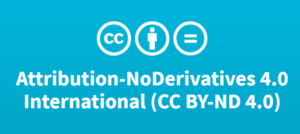
[1] Using a seven-point scale ranging from 1 (no risk) to 7 (substantial risk), the average number of adult smokers that rated each product 6/7 = high risk.
